NEET Biology The Living World Understanding Life
- Both life and non-living entities consist of identical elements and are regulated by the same physical laws.
- The estimated number of known living organisms is 1.7 million, comprising 1.2 million animals and 500,000 plants.
- All living organisms exhibit varying degrees of organization.
- Despite the fact that non-living components comprise live organisms, life cannot be generated merely by assembling all necessary ingredients in appropriate quantities.
- Aggregation, interaction, equilibrium, and transformation govern all forms of organizations.
- A living creature is both an autonomous entity and a component of the natural environment.
- Micro and macromolecules constitute life, and these molecules are perpetually engaged in interactions with one another.
- Approximately 5,000 compounds exist in the biosphere, encompassing 3,000 distinct reaction types.
- A cell may harbor 2000 enzymes to facilitate diverse metabolic pathways.
- Following water, proteins are the most prevalent compounds in the body.
- Cellulose is the predominant molecule in plants, whereas chitin is the most prevalent in animals.
- Energy transfers and transformations occur continuously within a living cell.
- Adenosine triphosphate (ATP) serves as the cellular energy currency.
- Biological processes harness free energy from their surroundings.
- Biological systems are governed by entropy.
The Living World NEET Notes
- Energy-releasing reactions that are capable of proceeding spontaneously are exergonic as aerobic respiration, lactic acid fermentation, and alcoholic fermentation
- Aerobic respiration: C6H12O6+6O2→6CO2+6H2O
- Lactic acid fermentation: C6H12O6→2C3H6O3
- Alcoholic fermentation: C6H12O6→2C2H5OH+2CO2
- Endergonic reactions are energy-consuming and cannot proceed at all unless energy is supplied continuously from an external source. fit Living organisms maintain their internal organization stable irrespective of changes in the environment.
- Reproduction is a characteristic feature of all living organisms and ensures the perpetuation of the species.
- DNA is the genetic material (RNA in plant viruses) and it is the only material capable of replication.
- Living organisms can adapt themselves according to need. LJ Living organisms have a definite life span. Death is the terminal stage of the life cycle.
- Death plays several positive roles such as reducing the population and recycling of materials.
- Life can be defined as a unique complex organization of molecules expressing itself through chemical reactions that lead to growth, development, responsiveness, adaptation, and reproduction.
- Atoms are nature’s building material All plants and animals and non-living substances are formed of matter.
- Any material in the universe that has mass and occupies a space is defined as matter. The building blocks of matter are atoms. These atoms aggregate and constitute elements.
- There are more tlum l(X) elements occurring in nature, out of these only 25 are essential to life. C. H, O. N, and P. S constitute about 98% of the mass of every living organism. performs the activities of life such as nutrition, growth, respiration, irritability, reproduction, etc.
Characteristics Of Living Organisms NEET
- It is the reversible crystallo-colloidal solution. Huxley called protoplasm the ‘physical basis of life’. Life without protoplasm cannot exist.
- Chemical bonds act as the glue of life Chemical bond. It is an attractive force that links two atoms to form a molecule. Covalent bond. When two atoms share a pair of valence electrons, the bond is called a covalent bond. Single bond.
- A bond in which a single pair of electrons is shared. Double bond. When four electrons are shared, the bond is called a double bond (O = O).
- The hydrogen bond is a weak chemical bond formed as a result of dipole-dipole interaction in which a partially electronegative atom of one molecule gets bonded to a partially electropositive but covalently held hydrogen atom.
- Water is a polar molecule. Molecules that exhibit charge separation are called polar molecules because of their magnetic poles. Therefore, water is a polar molecule. In the water molecule, the oxygen atoms bear a partial negative charge (d) and each hydrogen atom has a partial positive charge (d+).
- In liquid water, the negatively charged oxygen atom of one molecule of water is attracted to the positively charged hydrogen atom of another molecule of water. The bond resulting from this attraction is called a hydrogen bond.
- Biomolecules. The molecules present in living systems are called biomolecules. Micromolecules. They are simple molecules with low molecular weight.
- Micromolecules may be inorganic or organic. Inorganic micromolecules include water and inorganic salts. The organic macromolecules include sugar, amino acids, nitrogen bases, and nucleotides.
- The micromolecules are as important as macro molecules for living organisms. Whereas most of the organic micromolecules constitute the basic unit for the formation of macromolecules, water, and salts have their role to play.
- Macromolecules. They have a large size and their molecular weight runs into several thousands or even millions. All of them are organic compounds.
- A macromolecule is formed by the linking together of several smaller molecular units or monomers. This phenomenon is called Polymerisation.
- ACTH is a hormone that is the smallest protein with 39 amino acids and has mol. wt. 4500.
- Haemocyanin (a Cu++ containing respiratory pigment of mollusks) is the largest protein. It has mol. wt. 9,10,000 and 8200 amino acids.
- Term homeostasis was given by Cannon and refers to a favorable internal environment.
- Mayfly- 1 day
- Monkey- 26 days
- Cat- 35 to 40days
- Elephant- 65 days
- Man- 100 days
- Tortoise- 200 year
- Sequoia tree – 3000 years to 4000 years
- Wheat- 5 months
- Dog- 20 to 30 years (recordes 29 years 5 months)
- Horse- 60 years
- Eagle- 90 years
- Parrot- 140 years
- Banyan Tree- 200 years to 4000 years
- Ficus religious- 2000 years to 3000 years

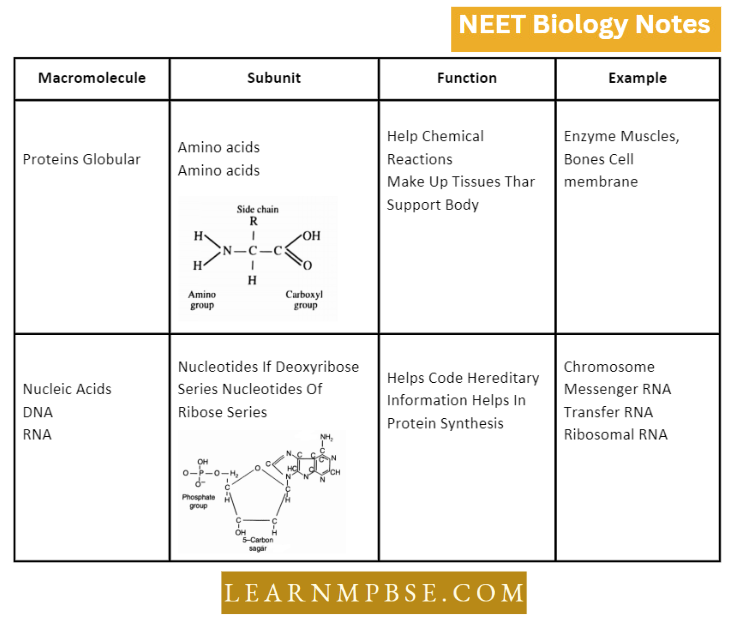
NEET Biology The Living World Growth And Development
Growth
- An increase in the mass or overall size of a tissue or organism or its parts is called growth.
- Growth occurs due to the synthesis of protoplasmic and apoplasmic substances.
- Protoplasmic substances include cytoplasm and nucleus.
- Apoplasmic substances produced by the cells constitute the matrix of the tissues.
- Growth as a result of metabolism involves the transfer of energy and it occurs when anabolism exceeds catabolism. There will be degrowth in reverse situations.
- Growth involves three processes in general:
- Cell proliferation
- Cell enlargement
- Secretion of extracellular matrix.
Development
- Development is characterized by three features Growth, Morphogenesis, and Differentiation.
- During morphogenesis cells begin to move or migrate, to shape the new individual For Example; A zygote develops into a blaslula, a blaslula into a gastrula, and so on.
- Differentiation is the process of tissue formation, cells change their shape and form and turn into particular types of cells, depending on their position in the body. Differentiation results in increasing diversity of cells.
Taxonomy And Systematics NEET
NEET Biology The Living World Energy Flow And Change In Living Systems
- Energy is the ability to do work, life requires a constant flow of energy to perform life functions.
- Energy exists in two states.
- Potential energy. The energy of position; and
- Kinetic energy. The energy of action. Much of the work performed by organisms involves changing potential energy (of food) to kinetic energy as exergonic reactions.
- All the energy changes that take place in the universe, from nuclear explosions to the buzzing of bees, are governed by two laws of thermodynamics.
- The first law is “ Energy is neither created nor destroyed, it only undergoes transfer or transformation.” Hence total amount of energy in the universe remains constant.
- The second law is “ All objects in the universe tend to come to disorder or randomness which is continually increasing in the universe.”
- In the process of transfer and transformation, a system (also an organism) loses some energy in the form of heat leading toward a state of randomness.
- The energy lost to disorder is referred to as entropy. Organisms minimize entropy by intake of food (input of energy).
- Although energy cannot come into or go out of the universe, Earth is constantly receiving energy from the Sun which heats the oceans and continents.
- Part of it is trapped by photosynthetic organisms to change it into chemical energy as endergonic reactions.
- The stored energy (ATP) can be shifted to other molecules by forming different chemical bonds or can be changed into kinetic energy; motion, light, electricity, and heat.
Enzymes direct Metabolic Pathways
- Enzyme. Any of a group of catalytic proteins that are produced by living cells, and that mediate and promote the chemical processes of life without themselves being altered or destroyed.
- Chemical reactions require activation energy to get started. Living systems contain enzymes that lower the activation energy. Life is therefore a process run by enzymes.
- Most enzymes are globular proteins with one or a few grooves on their surface called active sites which only particular substrates can fit into. Therefore enzyme-substrate interactions are specific and because of this, a cell can run a thousand reactions at a time.
- Each cell in our body contains 1000 to 5000 different types of enzymes.
- Enzyme activity is sensitive to the presence of modulators that bind to the enzymes.
- A substance that decreases the enzyme activity is called an inhibitor and if it increases the activity, it is an activator. Binding sites for these are called allosteric sites.
- Sometimes end product of the reaction acts as an allosteric inhibitor for the enzyme. This is also known as feedback or end-product inhibition.
Taxonomy And Systematics NEET
NEET Biology The Living World Homeostasis
- Hemostasis is the maintenance of the internal environment of the body. For this, all molecules cells tissues, organs, and systems must work together.
- A feedback system also operates which provides information about the physiological state and content of the system and appropriate adjustments are made accordingly.
- Most regulatory mechanisms of our body run through negative feedback loops.
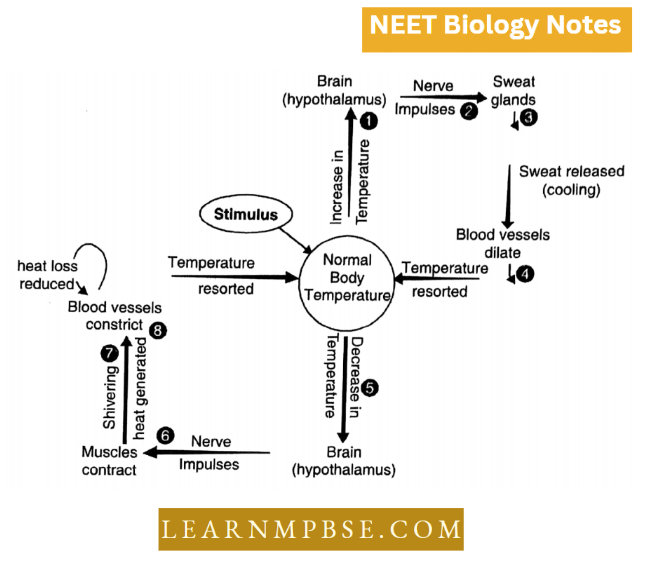
The Living World Class 11 Notes For NEET
NEET Biology The Living World Thermoregulation
- Thermal energy is generated during the exergonic events of metabolism.
- Ectothermic organisms predominantly dissipate their thermal energy to the surrounding environment. Examples include fish, amphibians, reptiles, and flora. Their body temperature fluctuates with the environment and is referred to as poikilotherms.
- Endothermic organisms conserve their heat energy for utilization. For instance, mammals, birds, and some fish such as tuna and swordfish. They possess insulating materials such as adipose tissue, fur, and plumage to minimize thermal dissipation to the surroundings.
- These species maintain a reasonably consistent body temperature and are referred to as homeotherms.
NEET Biology The Living World Important Points
NEET Biology The Living World Reproduction And Survival
Reproduction:
The process through which an organism produces offspring of the same species is termed reproduction.
- The fundamental characteristic of life is reproduction, and millions of years ago, DNA developed this capability. The continuation of organisms occurs via reproduction. “No entity endures eternally; nevertheless, existence persists.”
- DNA is the hereditary molecule that encompasses all information pertaining to growth, differentiation, and functioning, thus referred to as a “blueprint.
- ” The information encoded in DNA is utilized by cellular machinery to synthesize proteins, which may include enzymes or other types of molecules.
- Viruses possess genetic material but lack the cellular machinery to utilize it; instead, they exploit the machinery of host cells.
- Outside the live cell, they are inanimate; hence, their crystals can be preserved in a container for several years. A virus cannot be cultivated in an artificial media.
NEET Biology The Living World Important Points
NEET Biology The Living World Adaptation
- Adjustment to new or altered environmental conditions by changes in genotype or phenotype is called adaptation.
- Adapted organism means that its appearance, behavior, structure, and mode of life make it suitable to survive in a particular habitat.
- Every organism must be adapted if it is to survive.
- Adaptations arc of two types:
1. Short term adaptations
Useful variations that develop in specific conditions to overcome short unfavorable periods. Example:
- Hibernating animals become inactive in unfavorable conditions, metabolism becomes low; and the source of energy is stored fat.
- Dormancy of seeds, and their germination with the onset of favorable conditions.
- Tanning (darkening) of skin due to exposure to sunlight, more melanin is formed in the top layer of skin to protect the underlying tissue from solar radiation.
- Phototropism and geotropism are shown by growing plants.
2. Long-term adaptations
Useful variations that develop gradually over a long period as a permanent change, For Example:
- Different types of beaks and claws in birds for feeding and perching.
- The thick tail of the Kangaroo serves as the 5th limb.
- Backward protrusion of our ankle bone helps us stand erect.
- An opposable thumb in our hand makes it skillful.
- Female mosqutoes have to pierce and suck type mouth parts to suck human blood since the protein of mammalian blood is necessary for the production of their eggs.
- Desert plants are either leafless or have fleshy succulent stems covered by thick epidermis and wax layers.
- Night-blooming plants have either white or scented flowers to attract pollinators.
- The hummingbird (flower pecker) only hovers around the flower and does not sit on it as it can’t bear the bird’s load.
- The polymorphism in bees and termites is an adaptation for the division of labor in the colony.
- Aquatic plants have thin narrow ribbon-shaped orhighly dissected leaves to provide the least resistance to water currents and adsorb maximum light.
- The submerged parts are covered over by mucilage. Mechanical tissues are absent.
- Plants with both submerged and emerged leaves usually show heterophylism. The emerged leaves are broad and entire while the submerged ones are dissected or ribbon-like Example, Limnophila.
Biological Classification NEET
NEET Biology The Living World Death And Its Significance
- Life and death represent the dual aspects of existence. The term death pertains exclusively to larger organisms characterized by higher levels of biological complexity.
- At the cellular level, creatures do not perish as a cell splits into new cells; such organisms are termed “immortal,” exemplified by Amoeba, Paramecium, and Hydra.
- Each organism perpetuates its existence by its progeny, namely via gametes.
- Thus, “Death is the cost incurred for attaining a superior level of organization.”
- It is a self-regulating homeostatic mechanism that monitors population density to avert overcrowding.
- Death facilitates the recycling of matter, which is essential for maintaining equilibrium in nature.
- Dead cells and tissues, such as heartwood (sclerenchyma) and cork, play crucial roles in providing support and protection to living tissues. Vessels in sapwood function as conduits for transporting water and minerals to significant elevations.
- Histolysis of larval structures is necessary for the formation of adult structures during metamorphosis.
- Aging is a prerequisite for death, except accidental death. Therefore, it is an integral component of the life cycle.
- In humans, “clinical death” refers to the absence of a pulse and fixed pupils. Biological death transpires several hours later, as other tissues and organs continue to function for an extended period following clinical death. For transplantation, the organ or tissues are excised within minutes post-mortem.
- Occasionally, an organism may seem lifeless yet rejuvenates when favorable conditions return; for instance, the leaves of club moss (Selaginella lepidophylla), which appears as desiccated straw, regain its verdancy within hours of being submerged in water.
- The ease of Mvrothamnus and Cratemstigma in Africa is comparable. This arc is titled ‘The Resurrection Plant.
The Living World NEET Exam Preparation Notes
NEET Biology The Living World Virus
Virus: (Latin: Virus = venom or poisonous fluid) A large group of infectious agents ranging from 10-250 nanometres in diameter, composed of a protein sheath surrounding a nucleic acid core, characterized by total dependence on living cells for reproduction.
- Beijcrinck in 1898 in Holland found that the filtrable, invisible, and noncultivable infectious entity would diffuse through an agar gel, like a fluid. He thought the fluid itself alive and called it contagium vivum fluiduni i.c. a living infectious fluid.
- Viral diseases of vertebrates were well known by 1 892, Louis Pasteur had been studying canine rabies for some time. He indicated the cause of this disease as a virus. The term virus was then commonly used for a variety of infectious agents, including bacteria.
- LoefTler and Frosch in 1898. showed that the agent of foot-and-mouth disease of cattle, like TMV, passed through bacteria-retaining filters, and was neither visible with a microscope nor cultivable on inanimate media.
- Walter Reed (1900) and his associates discovered the virus of yellow fever, the first viral disease of man.
- Features of Virus
- They are not free-living and occur only as obligate intracellular parasites.
- They have only a single kind of nucleic either DNA or RNA, but never both.
- Nucleic acid is a single molecule, i.e., one replicon, which may be single or double-stranded.
- The outer shell-capsid is mostly of protein, except for a few animal viruses where additional polysaccharides are also present.
- They can be propagated in living culture media only.
- They contain no metabolic enzymes or protein synthetic machinery of their own.
- They use host machinery for the synthesis of their proteins.
- They replicate. They do not grow, but their nucleic acid directs the host cell to make various parts of the virus and then to assemble these parts into complete, infectious particles, virions.
- The virus is noil-cellular.
- Viruses behave as non-living outside and when inside living cells behave as living.
- In inert conditions it is non-living but whenever it comes in contact with an organism it multiplies and show’s living phase.
- It is a connecting link between non-living and living.
- Infection of a host cell by Virus. The steps involved in infection of host cell adsorption, separation of nucleic acid from the coat, penetration of nucleic acid, maturation, and release.
- Genetic recombination. Genetic recombination in the T-even phage was discovered in 1946 by Delbriick.
- Hershey, who. performed genetic crosses between infecting bacteria with a host range (h) and rapid-lysis (r) mutants of phages. It occurs by lysogeny, transduction, etc.
- Structure of Virus
The Living World NEET Exam Preparation Notes
Chemical Structure and Composition
Viruses have a very simple structure. A virus is made of a nucleic acid core and protein coat called a capsid which surrounds the core.
A fully assembled particle, i.e., a virion, is capable of infecting the host.
- The nucleic acid. A virion always contains only a single kind of nucleic acid, i.e., either DNA or RNA. The nucleic acid may occur as single or double strands. Plant viruses contain only single or double-stranded DNA or single or double-stranded RNA Bacterial viruses (bacteriophages) contain single or double-stranded DNA or single-stranded RNA.
- The infectious property of a virion is due to its nucleic acid. A host cell can synthesize complete virion if only free viral nucleic acid is injected within the cytoplasm of a living host cell.

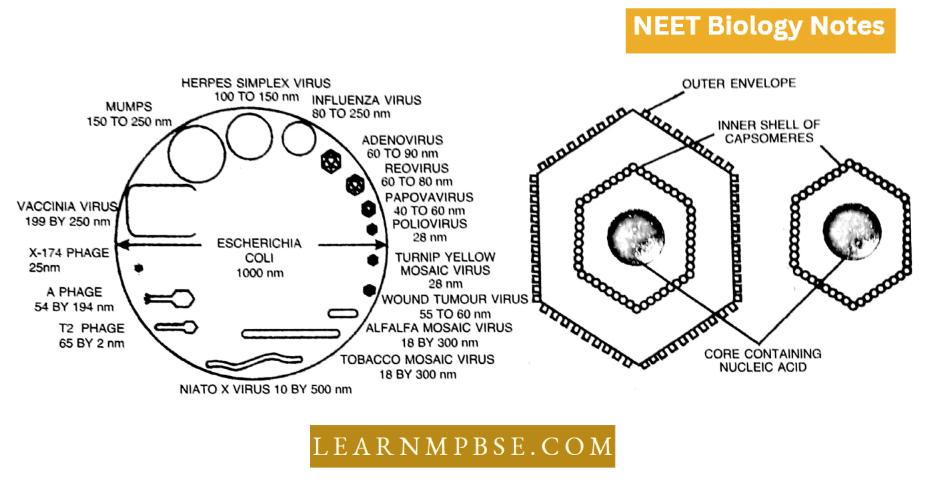
Capsid or the protein coat:
The protein shell is referred to as a capsid. It consists of several similar protein subunits known as capsomeres.
- Capsomeres consist of one or more types of proteins. The host specificity of viruses is attributed to the proteins of the capsid.
- In a viral particle, the capsomeres are organized symmetrically, imparting a distinct form to the virus.
- Certain larger virus particles, known as virions, possess an extra layer of lipids or lipoproteins surrounding the capsid.
- Virions with an extra coating are termed enveloped
- Example: Influenza virus, mumps virus), while those lacking this covering are designated as naked
- Example: TMV
Biological Classification NEET
NEET Biology The Living World Kinds Of Viruses based on Host
- Bacteriophages Viruses infecting bacterial cell
- Mycophage – Virus infecting fungi
- Cyanophage viruses infecting cyanobacteria (Safferman and Morris isolated from Plectonema)
- Coliphages Any bacteriophage infecting Escherichia coli
- Zoophages (Animal virus) Viruses infecting animal cells
- Phytophages (Plant viruses) Viruses infecting plant cells
- Protozoa Virus Infecting protozoa (Diamond and Mattem demonstrated virus infecting amoeba and entamoeba.
- Mycoplasmal viruses infecting mycoplasma (Gourlay 1970)
- Satellite viruses (Incomplete viruses). Sometimes one virus may depend upon the assistance of another virus in the same cell to help it perform a necessary function of its existence.
- The first satellite virus to be recorded was found in association with a virus disease of tobacco, tobacco necrosis (Kassanis, 1963).
- Slow viruses (Prions). Prions are described as proteinaceous particles thought to cause many diseases including the slow virus diseases.
- Prions were named by Stanley B. Prusiner. Prions can survive heat, radiation, and chemical treatments that normally ate, They appear to be composed of only proteins.
- He viruses cause a range of infections viz. acute, chronic, persistent, latent, slowly progressive, and infections.
NEET Biology The Living World Study Material
NEET Biology The Living World Some Important Viruses
- Influenza – Paramyxovirus
- Smallpox – Variolla virus
- Measles – Paramyxovirus
- Polio – Enterovirus
- German measles (Rubella) Tago viru
- Cold – Orthoinyxo virus
- Chickenpox – Varicella virus
- Mumps – Paramyxovirus
- Rabies – Rhadbo virus
- HIV – Human Immuno Deficiency Virus
Some Common diseases of plains are caused by Viruses
- Rosette disease
- Little leaf of Brinjal
- Yellow vein mosaic
- Potato leafroll
- Leaf curl of papaya
- Bunchy top
- Grassy shoot
- Tobacco mosaic
Biological Classification NEET
Classification and Nomenclature of Viruses
- Numerous classification methods have been offered repeatedly. Their classification mostly relied on host range, clinical epidemiology, and pathological signs.
- The categorization put forth by Lwoaff Horne and Tournler (1962) was utilized more frequently than alternative classifications.
- The classification was determined by the type of nucleic acid found in viruses. The International Committee on Virus Nomenclature has established a standard for virus nomenclature. The designation comprises two components.
- The initial segment represents the virus’s common name, whereas the subsequent segment encompasses the encoded information pertaining to the virus.
The second part is known as the cryptogram. It contains the following four pairs:
- The first pair – represents the type of nucleic acid/number of strands in nucleic acid.
- The second pair – represents the molecular weight of nucleic acid/amount of nucleic acid expressed as a percentage.
- The third pair – denotes the shape of the virus shape of nucleoprotein.
- The fourth pair- denotes the type of host carrier used in the transmission of the virus.
Example. The cryptogram of Tobacco Mosaic Virus (TMV)
R/l : 2/5 : E/E S/A
It can be explained as under:
- First pair – Nucleic acid – RNA (R) single-stranded – (1).
- Second pair – Molecular weight of nucleic acid – (2) hundred thousand/ Amount of nucleic acid (5%).
- Third pair – Shape of virus – elongated (E)/shape of nucleoprotein- elongated (E).
- Fourth pair – Host – seed plants or spermatophytes (S)/carrier of transmission – air.
NEET Biology The Living World Study Material
Example. The Cryptogram of Influenza Virus
- R/I : (2-3)/10 : S/E: V/A
- It can be explained as under:
- First pair: Nucleic acid – RNA (R)/single-stranded – (1)
- Second pair- Molecular weight of nucleic acid – (2 or 3) hundred thousand/ Amount of nucleic acid (10%).
- Third pair – Shape of virus – spherical (S)/shape of nucleoprotein – elongated (E).
- Fourth pair – Host – vertebrate (V)Transmission by – air
- Classification of human viral diseases based on the tissue affected

- NaCl is an important constituent of our blood. It plays a role in the maintenance of erythrocytes in blood.
- Carbon is the main sinistral element of living cells and
- CO2 is the main source.
- Molecular oxygen is necessary for life.
- Energy transfers and energy transformations continuously take place in a living cell.
- Carbohydrates are the main energy sources.
- Glucose of the simplest carbohydrate.
- Lipids are a major group of insoluble hydrocarbons. They are the main constituents of the membranes of the cell.
- Steroids form hormones.
- Proteins are the building materials of the body.
- Amino acids are the building blocks of proteins.
- Nucleic acids are information storage devices of cells.
- DNA and RNA are the two main nucleic acids formed by nucleotides.
- Adenosine triphosphate (ATP) is the ‘energy currency’ of the cell.
- The living system utilizes free energy from the environment.
- Living systems also billow both laws of ilicrmodynamies
- Living systems are subject to entropy.
- Living organisms maintain their internal organization
- stable irrespective of changes in the environment. It is termed homeostasis.
- Living systems are open systems.
- Metabolism is the total of all chemical reactions taking place in the body.
- Metabolism reactions are of two types i.e. building up reactions termed anabolism and breaking down reactions as catabolism.
- All metabolic reactions are regulated and directed by enzymes.
- Enzymes are proteinic substances and act as catalysts, thus termed biocatalysts.
- Biochemical pathways are regulated and often depend upon the allosteric site of the enzyme.
- Organisms may be poikilothermal or homeothermal about the regulation of temperature.
Hierarchy Of Classification NEET
NEET Biology The Living World Quanta To Memory
- In vitro. Studies in artificial medium.
- In vivo. Studies in natural medium.
- The oldest living tree is the bristle cone pine named Methuselah at 10,000 ft. on the calif side of the white mountains, with a confined age of 4600 years.
- Amoeba, bacteria, and Paramecium are thought to be immortal as these do not suffer from natural death.
- It has not been possible to create life because the nature of the molecular organization is complex and has not been completely understood.
- The art of keeping tissues and organs alive outside the body of an animal was demonstrated by Sidney Ringer.
- Homeostasis is maintained at the level of the organism as a whole with the cellular level as the basis.
- Resurrection plants like Selaginella lepidophylla dry up in humid conditions but become green and alive with rain. Other examples are Craterostigma and Myrothamnus.
- The concentration of salt in the body is .9% (0.9 gm in 100 ml) and it is isotonic with the cytosol. The life span of Macrozainia is about 10,000 to 12,000 years.
- Kangaroo rat lives in arid areas. It does not drink water and depends upon only metabolic water. It feeds on dry seeds.
- Neoteny: a phenomenon in which. the larva develops the gonads and starts reproduction without undergoing metamorphosis example, the Axolotl larva of Ambystoma (Tiger salamander).
- Mammalian RBCs are biconcave and enucleated except for Camel and Llama.
- The tusks of elephants are upper incisors while the tusks of walruses are upper canines.
- Peplomeres. The envelope is composed of both viral and host components. Peplomeres represent the subunits. Capsomeres. Capsid is made of identical protein subunits capsomeres.
- Flowers of Oplirys nucifera resemble the females of Calpa-aurea and are pollinated by male wasps.
- Bushmen of the Kalahari desert employ signals of fingers and thumbs to indicate animals during hunting. A.T.P. is called the energy currency of cells (Lipman 1941).
The Living World NEET Chapter Summary
NEET Biology The Living World Questions From Competitive Examinations
Question 1. Saline DNP is given to patients suffering from cholera as
- Na+ ions help in the retention of water in body tissues
- Ncal is involved in the supply of energy
- Naci furnishes most of the cell fuel
- Nacl impairs nerve impulses involved in the transmission of pain sensation.
Answer: 1. Na+ ions help in the retention of water in body tissues
Question 2. Vims that have an arthropod as an intermediate host before attacking a vertebrate is :
- Rcovirus
- Adenovirus
- Papovavirus
- Parvovirus.
Answer: 2. Adenovirus
Question 3. Caulimo (cauliflower mosaic) viruses have :
- Dsdna
- Ssdna
- Ssrna
- Dsrna.
Answer: 1. dsDNA
Question 4. Which of the following is not an adaptive feature?
- Phototropism
- Cell division
- Hibernation
- Accommodation.
Answer: 2. Cell division
The Living World NEET Chapter Summary
Question 5. Tire process which cannot take place in the absence of viruses:
- Transformation
- Conjugation
- Translocation
- Transduction.
Answer: 4. Transduction.
Question 6. Mimicry is for:
- Offense and defense
- Concealment
- Offense
- Transition
Answer: 1. Offence and defence
Question 7. Volant adaptation is for :
- Swimming
- Flying
- Climbing
- Running.
Answer: 2. Flying
Question 8. The smallest unit of life is :
- Dna
- Rna
- Cell
- Protein.
Answer: 3. Cell
Question 9. When a spontaneous process occurs then :
- Free energy decreases
- Free energy increases
- Free energy remains constant.
- Sometimes increases and sometimes decreases.
Answer: 2. Free energy increases
Question 10. Each molecule of NADH-, releases how many ATP molecules?
- 3
- 2
- 4
- 8.
Answer: 1. 2
Question 11. The maximum life span of a dog is :
- 5 Years
- 10 Years
- 15 Years
- 20 Years.
Answer: 4. 20 Years.
Hierarchy Of Classification NEET
Question 12. The most abundant element present in plants is :
- Manganese
- Eon
- Carbon
- Nitrogen
Answer: 3. Carbon
Question 13. Living steady state has a self-regulatory mechanism called:
- Feedback mechanism
- Homeothermy
- Homozygosity
- Homeostasis.
Answer: 4. Homeostasis.
Question 14. Energy flow and energy transformations of a living system follow-:
- Law of limiting factor
- Law of thermodynamics
- Liebig’s law of minimum
- Biogenetic law.
Answer: 2. Law of thermodynamics
Question 15. The statement correct about enzymes is :
- They are amino acids
- They are most active at a temperature of 0°c
- They are all proteins
- They are most active at pH 6.9.
Answer: 3. They are all proteins
Question 16. During strenuous exercise glucose is converted into :
- Glycogen
- Pyruvic acid
- Starch
- Lactic acid.
Answer: 4. Lactic acid.
Question 17. In which form is the food transported in plants 7
- Sucrose
- Fructose
- Glucose
- Lactose.
Answer: 1. Sucrose
Hierarchy Of Classification NEET
Question 18. Which one of the following statements regarding enzyme inhibition is correct :
- Competitive inhibition is seen when a substrate competes with an enzyme for binding to an inhibitor protein
- Competitive inhibition is seen when the substrate and the inhibitor compete for the active site on the enzyme
- Non-competitive inhibition of an enzyme can be overcome by adding a large amount of substrate
- Non-competitive inhibitors often bind to the enzyme irreversibly.
Answer: 2. Competitive inhibition is seen when the substrate and the inhibitor compete for the active site on the enzyme
Question 19. An organic substance bound to an enzyme and essential for its activity is called :
- Co-enzyme
- Holoenzyme
- Apoenzyme
- Isoenzyme.
Answer: 1. Co-enzyme
Question 20. An enzyme that can stimulate the germination of barley seeds is:
- A-amylase
- Lipase
- Protease
- Invertase.
Answer: 1. A-amylase
Question 21. Which of the following processes needs bacteriophage?
- Translation
- Conjugation
- Transformation
- Transduction.
Answer: 4. Transduction.
Question 22. Transfer of genetic information through virus is :
- Conjugation
- Conduction
- Transduction
- Transformation.
Answer: 3. Transduction
Question 23. The virus that infects bacteria is made up of :
- Protein only
- Dna and lipid
- Dna and protein
- Rna and protein.
Answer: 3. Dna and protein
The Living World NEET Notes
Question 24. Identify the hepatitis vims, that cannot survive independently and it require another hepatitis vims for its multiplication :
- Hepatitis-a vims
- Hepatitis-b vims
- Hepatitis-c vims
- Hepatitis-d vims.
Answer: 4. Hepatitis-d vims.
Question 25. Which has ssrna?
- Hav
- Hbv
- Ascaris
- Entamoeba
Answer: 1. Hav
Question 26. Blumberg (1963) discovered :
- Hiv
- Hbv
- Hav
- Cold vims.
Answer: 2. Hbv
Question 27. Small proteins produced by vertebrate cells naturally in response to viral infections and which inhibit the multiplication of viruses are called :
- Antitoxins
- Interferons
- Lipoproteins
- Immunoglobulins.
Answer: 2. Interferons
Question 28. The genetic material of retrovirus is :
- DNA
- RNA
- Both DNA and RNA
- None of these.
Answer: 2. RNA
Question 29. Provirus is :
- A free vims
- A free DNA
- Primitive vims
- Integrated viral genome
Answer: 4. Integrated viral genome
Question 30. Viroids cause :
- Tobacco mosaic
- Tulip yellow mosaic
- Cauliflower mosaic
- Potato spindle mosaic.
Answer: 4. Potato spindle mosaic.
The Living World NEET Notes
Question 31. The host of TMV is:
- Datura
- Triticum
- Nicotiana
- Withania.
Answer: 3. Nicotiana
Question 32. Prions are infectious agents associated with mad cow disease. These agents are :
- DNA
- RNA
- Proteins
- All of the above.
Answer: 3. Proteins
Question 33. A virus envelope is known as :
- Virion
- Nucleoprotein
- Core
- Capsid.
Answer: 4. Capsid.
Neet Special Self Assessment Test Unit The Living World
Question 1. Match the terms in column a with suitable terms in column b. Column b.
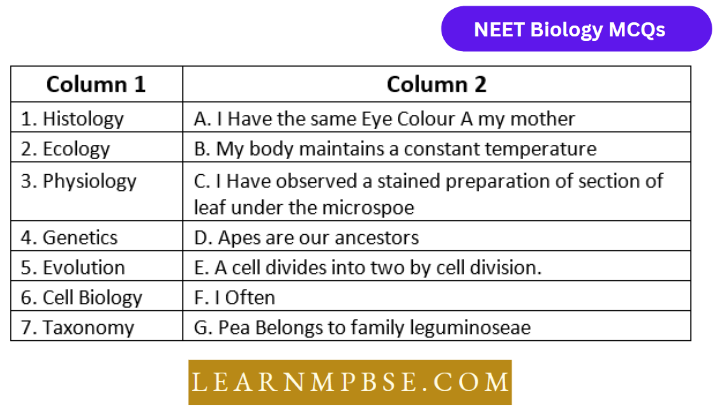
- 1-C,2-F,3-B,4-A,5-D,6-E,7-G
- 1-D,2-B,3-A,4-E,5-F,6-G,7-C
- 1-C,2-F,3-B,4-G,5-A,6-D,7-E
- 1-C,2-F,3-B,4-E,5-D,6-A,7-G
Answer: 1. 1-C,2-F,3-B,4-A,5-D,6-E,7-G
Question 2. Match the words of column 1 with that of column 2.
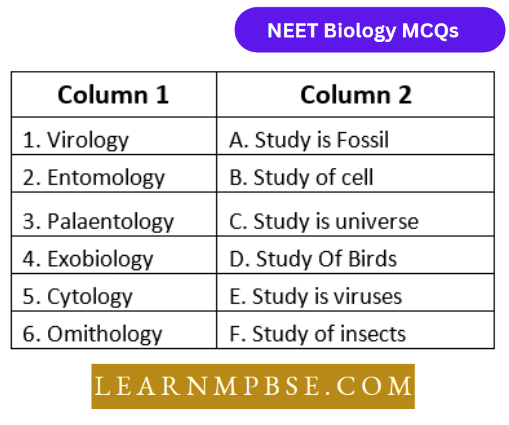
- 1-F,2-E,3-D,4-C,5-B,6-A,
- 1-E,2-F,3-A,4-C,5-B,6-D
- 1-E,2-F,3-A,4-B,5-C,6-D
- 1-E,2-F,3-A,4-C,5-D,6-B
Answer: 2. 1-E,2-F,3-A,4-C,5-B,6-D
Characteristics Of Living Organisms NEET
Question 3. Which of the following is the correct sequence of scientific methods of gathering information?
- Observation, formulation of hypothesis, testing of hypothesis, developing theory
- Formulation of hypothesis, testing of hypothesis, developing theory
- Observation, testing of hypothesis, formulation of hypothesis, developing theory
- Developing theory, observation, formulation of hypothesis, and testing of hypothesis.
Answer: 2. Formulation of hypothesis, testing of hypothesis, developing theory.
Question 4. Which of the billowing is a card statement?
- A hypothesis is a tentative theory
- The hypothesis is an intelligent guess
- The control experiment establishes the validity of the working experiment.
- All of the above.
Answer: 4. All of the above.
Question 5. Match the items in column 1 with those in column 2 Which of the following is correct?
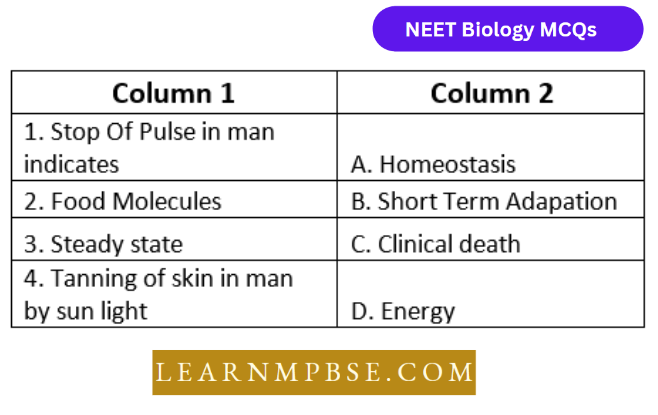
- 1-C,2-D,3-D,4-A
- 1-C,2-B,3-A,4-D
- 1-C,2-B,3-A,4-D
- 1-C,2-D,3-A,4-B
Answer: 4. 1-C,2-D,3-A,4-B
Question 6. Match die statements of the two columns column 1 column 2
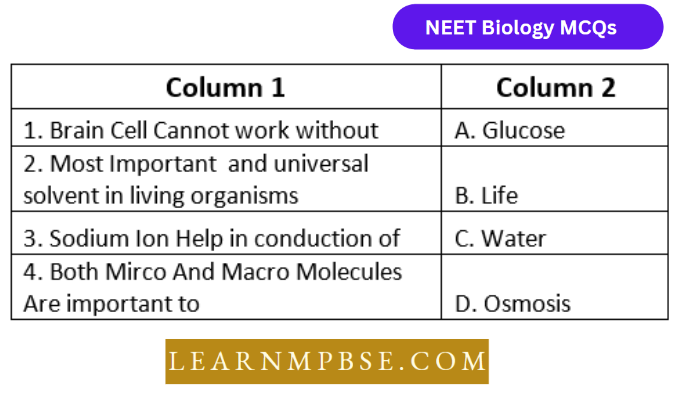
- 1-A,2-D,3-D,4-E
- 1-A,2-B,3-D,4-C
- 1-A,2-C,3-D,4-B
- 1-A,2-B,3-B,4-D
Answer: 3. 1-A,2-C,3-D,4-B
Question 7. As a result of decomposition after death :
- C, H, O. N. P. S. K. Ca is returned to the ecosystem
- Get the above elements recycled
- These elements are freed from their covalent bonds
- All of the above.
Answer: 4. All of the above.
Question 8. A living organism is considered to be open system because it has access to:
- Matter
- Energy
- Matte and energy
- Sunlight and matter.
Answer: 3. Matte and energy
Question 9. Carbon is a principal structural element of living cells. The carbon is obtained by living systems from :
- Glucose
- C02 of atmosphere
- Inorganic c02 dissolved in water
- Any organic molecule.
Answer: 3. Inorganic c02 dissolved in water
The Living World NEET Chapter Summary
Question 10. Which of the following is the main energy storage molecule in all living systems?
- Lipids
- Proteins
- Carbohydrates
- Both 1 and 3
Answer: 3. Carbohydrates
Question 11. Membranes often contain steroids. It is a type of:
- Lipids that contain four carbon ring
- Lipid with a long chain
- Formed of 15-carbon fatty acid
- All of the above.
Answer: 1. Lipids that contain four carbon ring
Question 12. For water to become a vapor, there must be sufficient heat energy to :
- Break its hydrogen bonds
- Break its covalent bonds
- Lower its specific heat
- Raise its specific heat.
Answer: 1. Break its hydrogen bonds
Question 13. A molecule that adds hydrogen ions to a solution is known as
- Buffer
- Base
- An acid
- A hydrophobic substance.
Answer: 3. An acid
Question 14. Which of the following is not an example of an open system?
- Cell
- Living system
- Thermos flask
- Blue-green alga.
Answer: 3. Thermos flask
Question 15. Growth occurs due to :
- Synthesis of apoplastic substances
- Synthesis of protoplasmic substances
- Metabolism which involves the transfer of energy
- All of the above.
Answer: 4. All of the above.
